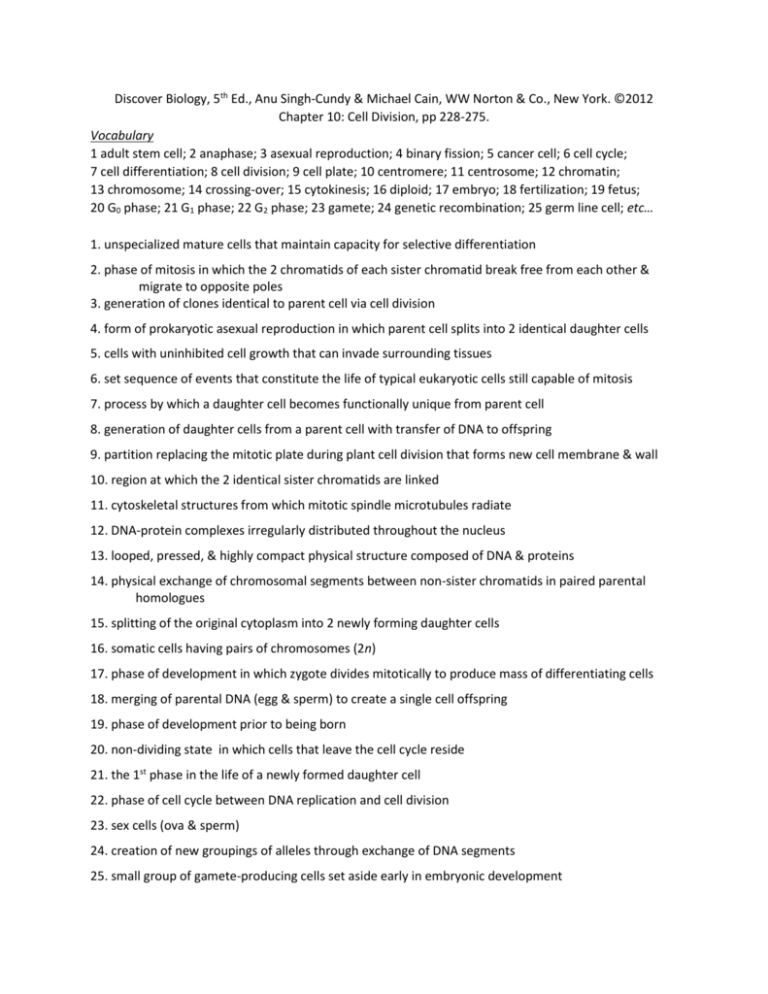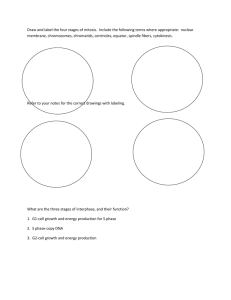C10: Cell Division Voc Definitions
advertisement

Discover Biology, 5th Ed., Anu Singh-Cundy & Michael Cain, WW Norton & Co., New York. ©2012 Chapter 10: Cell Division, pp 228-275. Vocabulary 1 adult stem cell; 2 anaphase; 3 asexual reproduction; 4 binary fission; 5 cancer cell; 6 cell cycle; 7 cell differentiation; 8 cell division; 9 cell plate; 10 centromere; 11 centrosome; 12 chromatin; 13 chromosome; 14 crossing-over; 15 cytokinesis; 16 diploid; 17 embryo; 18 fertilization; 19 fetus; 20 G0 phase; 21 G1 phase; 22 G2 phase; 23 gamete; 24 genetic recombination; 25 germ line cell; etc… 1. unspecialized mature cells that maintain capacity for selective differentiation 2. phase of mitosis in which the 2 chromatids of each sister chromatid break free from each other & migrate to opposite poles 3. generation of clones identical to parent cell via cell division 4. form of prokaryotic asexual reproduction in which parent cell splits into 2 identical daughter cells 5. cells with uninhibited cell growth that can invade surrounding tissues 6. set sequence of events that constitute the life of typical eukaryotic cells still capable of mitosis 7. process by which a daughter cell becomes functionally unique from parent cell 8. generation of daughter cells from a parent cell with transfer of DNA to offspring 9. partition replacing the mitotic plate during plant cell division that forms new cell membrane & wall 10. region at which the 2 identical sister chromatids are linked 11. cytoskeletal structures from which mitotic spindle microtubules radiate 12. DNA-protein complexes irregularly distributed throughout the nucleus 13. looped, pressed, & highly compact physical structure composed of DNA & proteins 14. physical exchange of chromosomal segments between non-sister chromatids in paired parental homologues 15. splitting of the original cytoplasm into 2 newly forming daughter cells 16. somatic cells having pairs of chromosomes (2n) 17. phase of development in which zygote divides mitotically to produce mass of differentiating cells 18. merging of parental DNA (egg & sperm) to create a single cell offspring 19. phase of development prior to being born 20. non-dividing state in which cells that leave the cell cycle reside 21. the 1st phase in the life of a newly formed daughter cell 22. phase of cell cycle between DNA replication and cell division 23. sex cells (ova & sperm) 24. creation of new groupings of alleles through exchange of DNA segments 25. small group of gamete-producing cells set aside early in embryonic development 26 haploid; 27 homologous chromosome; 28 independent assortment of chromosomes; 29 interphase; 30 karyotype; 31 maternal homologue; 32 meiosis; 33 meiosis I; 34 meiosis II; 35 metaphase; 36 mitosis; 37 mitotic division; 38 mitotic spindle; 39 paternal homologue; 40 prophase; 41 S phase; 42 sex chromosome; 43 sexual reproduction; 44 sister chromatids; 45 somatic cell; 46 telophase; 47 tetrad; 48 tumor; 49 zygote Extra words: 50 kinetochores 26. gametes having only 1 copy of each type of chromosome (1n) 27. a pair of 2 matched chromosomes 28. random distribution of different homologous chromosome pairs into daughter cells during meiosis I 29. phase of cell cycle in which cells proceed with all life functions other than cell division 30. pictograph display of all the somatic cell chromosomes 31. the 1 homologous chromosome received from the female parent 32. specialized type of cell division that makes sexual reproductive cells 33. process in which each homologous pair of chromosomes is separated into 2 different daughter cells 34. process in which each sister chromatid is separated into 2 different daughter cells 35. phase of mitosis in which replicated chromosomes are aligned in a row mid-center of the cell 36. division of the nucleus initiating mitotic division 37. process in which an eukaryotic parent cell forms 2 genetically identical daughter cells 38. spokelike microtubule array responsible for pulling chromosomes to opposite poles during mitosis 39. the 1 homologous chromosome received from the male parent 40. 1st stage of mitosis in which DNA is further compacted, centrosomes migrate to opposite poles, & the mitotic spindle begins to form 41. part of the cell cycle in which DNA is replicated (2n 4n) 42. the X or Y chromosome 43. generation of genetically unique offspring via combination of DNA from 2 opposite mating types 44. two linked, identical DNA double helices resulting from replication 45. non-sex cells in multicellular organisms 46. mitotic phase in which a complete set of daughter chromosomes arrives at cell’s pole, mitotic spindle disintegrates, & nuclear envelope reforms 47. structure in which paternal & maternal homologues (4 individual DNA molecules) are closely aligned 48. a mass of cells produced from unregulated cell growth 49. initial diploid-cell product of sexual reproduction 50. two patches of proteins flanking each centromere allowing attachment of microtubules to each sister chromatid











